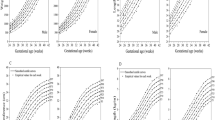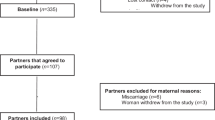Abstract
Objective: To investigate the determinants of neonatal weight and length.
Design: From 16–20 week of pregnancy, 366 mothers of the neonates had participated in the community-based study to investigate the effect of weekly supplementation during pregnancy with iron and vitamin A on infant growth. Women from five villages were allocated randomly to receive two tablets each containing 60 mg iron as ferrous sulphate and 250 µg folic acid (n=121) or two tablets each containing 2400 RE vitamin A in addition to the same amount of ferrous sulphate and folic acid (n=122). A third (‘daily’) group (n=123) participating in the national iron supplementation programme was recruited from four neighbouring villages.
Results: Neonatal weight and length did not differ between the two weekly groups and between the weekly iron group and the ‘daily’ group. Iron and vitamin A status during pregnancy did not influence neonatal weight and length significantly. Boys were 100 g heavier and 0.53 cm longer than girls (P<0.05). First born neonates were lighter (P<0.01) and tended to be shorter (P=0.070) than neonates of higher birth order. Maternal age and education as well as other socioeconomic determinants were not associated with neonatal weight and length. Neonatal weight was 32% explained by gestational age, maternal weight, postnatal measurement, gender and parity, while neonatal length was 28% explained by gestational age, maternal weight, postnatal measurement, gender and maternal height.
Conclusions: Gestational age, maternal weight at second trimester and infant gender were the main predictors of neonatal weight and length.
Sponsorship: The study was supported by The Netherlands Organization for Scientific Research-Netherlands Foundation for the Advancement of Tropical Research (NWO-WOTRO; WV 93-280) and Neys-van Hoogstraten Foundation (IN 114), The Netherlands, and German Agency for Technical Cooperation (GTZ)/South East Asian Ministers of Education Organization (SEAMEO), Indonesia.
This is a preview of subscription content, access via your institution
Access options
Subscribe to this journal
Receive 12 print issues and online access
$259.00 per year
only $21.58 per issue
Buy this article
- Purchase on SpringerLink
- Instant access to full article PDF
Prices may be subject to local taxes which are calculated during checkout
Similar content being viewed by others
References
Abrams B, Selvin S . 1995 Maternal weight gain pattern and birth weight Obstet. Gynecol. 86: 163–169
Abrams B, Altman SL, Pickett KE . 2000 Pregnancy weight gain: still controversial Am. J. Clin. Nutr. 71: (Suppl): 1233S–1241S
Achadi EL, Hansell MJ, Sloan NL, Anderson MA . 1995 Women's nutritional status, iron consumption and weight gain during pregnancy in relation to neonatal weight and length in West Java, Indonesia Int. J. Gynecol. Obstet. 48: (Suppl): S103–S119
Allen LH . 2000 Anemia and iron deficiency: effects on pregnancy outcome Am. J. Clin. Nutr. 71: (Suppl): 1280S–1284S
Barker DJP . 1994 Mothers, Babies, and Disease in Later Life London: BMJ Publishing Group
de Onis M, Blössner M, Villar J . 1998a Levels and patterns of intrauterine growth retardation in developing countries Eur. J. Clin. Nutr. 52: (S1): S5–S15
de Onis M, Villar J, Gulmezoglu M . 1998b Nutritional interventions to prevent intrauterine growth retardation: evidence from randomized controlled trials Eur. J. Clin. Nutr. 52: (S1): S83–S93
Gross R, Kielmann A, Korte R, Schoeneberger H, Schultink W . 1997 Guidelines for nutrition baseline surveys in communities Bangkok: SEAMEO-TROPMED and Deutsche Gesellschaft für Technische Zusammenarbeit (GTZ)
Howells DH, Haste F, Rosenberg D, Brown IRF, Brooke OG . 1986 Investigation of vitamin A nutrition in pregnant British Asians and their infants Hum. Nutr. Clin. Nutr. 40C: 43–50
Kardjati S, Kusin JA, de With C . 1988 Energy supplementation in the last trimester of pregnancy in East Java: I. Effect on birthweight Br. J. Obstet. Gynaecol. 95: 783–794
Kramer MS . 1987 Determinants of low birth weight: methodological assessment and meta-analysis Bull. WHO 65: 663–737
Kramer MS . 1998 Socioeconomic determinants of intrauterine growth retardation Eur. J. Clin. Nutr. 52: (S1): S29–S33
Krasovec K . 1991 Part I. Weight gain in pregnancy In: Maternal Nutrition and Pregnancy Outcomes. Anthropometric Assessment ed. K Krasovec & MA Anderson, pp 15–55 Washington, DC: PAHO
Muslimatun S, Schmidt MK, Schultink W, West CE, Hautvast JGAJ, Gross R, Muhilal . 2001 Weekly supplementation with iron and vitamin A during pregnancy increases hemoglobin concentration but decreases serum ferritin concentration in Indonesian pregnant women J. Nutr. 131: 85–90
Prentice AM, Cole TJ, Foord FA, Lamb WH, Whitehead RG . 1987 Increased birthweight after prenatal dietary supplementation of rural African women Am. J. Clin. Nutr. 46: 912–925
Preziosi P, Prual A, Galan P, Daouda H, Buoreima H, Hercberg S . 1997 Effect of iron supplementation on the iron status of pregnant women: consequences for newborns Am. J. Clin. Nutr. 66: 1178–1182
Scholl TO, Reilly T . 2000 Anemia, iron and pregnancy outcome J. Nutr. 130: 443S–447S
Shah RS, Rajalakshmi R . 1984 Vitamin A status of the newborn in relation to gestational age, body weight, and maternal nutritional status Am. J. Clin. Nutr. 40: 794–800
Strauss RS, Dietz WH . 1999 Low maternal weight gain in the second or third trimester increases the risk for intrauterine growth retardation J. Nutr. 129: 988–993
Suharno D, West CE, Muhilal, Karyadi D, Hautvast JGAJ . 1993 Supplementation with vitamin A and iron for nutritional anaemia in pregnant women in West Java, Indonesia Lancet 342: 1325–1328
Tuntiseranee P, Olsen J, Chongsuvivatwong V, Limbutara S . 1999 Socioeconomic and work related determinants of pregnancy outcome in southern Thailand J. Epidemiol. Community Health 53: 624–629
WHO. 1995 Maternal anthropometry and pregnancy outcomes. A WHO collaborative study Bull. WHO 73: (Suppl): 1–98
Acknowledgements
We gratefully acknowledged the participation and co-operation of pregnant women, heads of villages and health centres in Leuwiliang, Bogor, Indonesia. The comment on the manuscript provided by Dr AA Kielmann is highly appreciated.
Author information
Authors and Affiliations
Corresponding author
Rights and permissions
About this article
Cite this article
Muslimatun, S., Schmidt, M., West, C. et al. Determinants of weight and length of Indonesian neonates. Eur J Clin Nutr 56, 947–951 (2002). https://doi.org/10.1038/sj.ejcn.1601439
Published:
Issue date:
DOI: https://doi.org/10.1038/sj.ejcn.1601439



